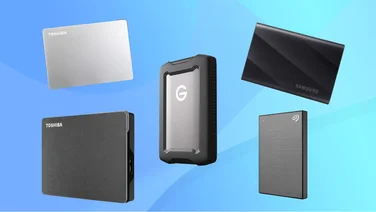To help us provide you with free impartial advice, we may earn a commission if you buy through links on our site. Learn more




- Tough construction
- Impressive sequential read/write speeds
- Fantastic random read speeds
- Oddly slow random write speeds
- Performance varies from system to system
For the last few years, the USB interface has been the biggest bottleneck on external SSDs, with USB 3.2 gen 2×2 limited to 2,000MB/sec, and only the odd Thunderbolt 4 or Thunderbolt 5 drive going any faster. That’s changing now, though, thanks to growing support for USB 4 on Windows laptops, either native or through Thunderbolt 4. With a maximum 4.8GB/sec bandwidth – double the bandwidth of USB 3.2 gen 2×2 – there’s scope to run external SSDs at close to the same speeds as internal drives, meaning you can work, create or game with an external drive without your performance being seriously hobbled.
The SanDisk Extreme Pro with USB4 is one of the first USB4 drives to be widely available, and the first I’ve had an opportunity to test. While it’s expensive for an external SSD, the increase in speed could make the extra outlay worth your while.
What do you get for the money?
A ruggedised portable SSD with a single USB4 connector and a 240W/40Gbit/sec cable (older cables may not deliver the full speed). At 140 x 69mm and just under 12mm thick, it’s a little larger than the existing SanDisk Extreme Pro with USB 3.2 Gen 2×2, and also heavier at 170g rather than 77.5g. In other respects, though, it’s very similar, with a forged aluminium chassis that acts as a heatsink covered in a tough silicone outer shell. It can work in temperatures of 5°C to 45°C, and its IP65 water resistant to cover against weather, spills and drops.




I reviewed the 2TB version, but there is also a 4TB version should you need more capacity.
How does it perform?
The big deal here is the rated speeds, with SanDisk claiming read speeds of up to 3800MB/sec and write speeds of up to 3700MB/sec. In tests with a Mac Mini M4 and Amorphous DiskMark, I couldn’t match these figures, but sequential speeds were still significantly ahead of even the fastest USB 3.2 Gen 2×2 drives, at 3444.26MB/sec and 3249MB/sec. What’s more, random 4K read speeds are stellar, reaching 657.62MB/sec, though write speeds are oddly slow, at just 70.8MB/sec. To put that in perspective, we’ve had USB 3.2 Gen 2 Type C drives with random read/write speeds of over 200MB/sec.
How does that compare with the fastest external SSD we’ve tested – the LaCie Rugged SSD Pro5? Well, matching the same settings (file size 32GiB, queue depth 8, streams 1, write pattern 0x00000000) in the Atto drive benchmark, the Extreme Pro gave us speeds of 3.42GB/sec and 3.25GB/sec, where LaCie’s Thunderbolt 5 drive scored 7.05GB/sec and 5.11GB/sec. In short, it’s not close.




But then most of us not engaged in high-end creative endeavours don’t need that level of performance from an external SSD, and even more of us don’t have the Thunderbolt 5 connectivity required to run it. The Extreme Pro is fast enough for file storage and transfer duties, or even to run applications from the drive, bar video editing apps and games where latency might just be an issue.
Just be aware that you’ll only get the best performance with a PC or laptop that has USB4 onboard, and even then your mileage may vary. Running on a Dell XPS 13 Copilot+ PC, I was unable to get sequential write speeds above 2533MB/sec or read speeds above 2605MB/sec, even after driver updates and a BIOS update. This might be an issue with the laptop or an issue with USB4 support. Until I have more drives in for test I can’t be sure.
Are there any useful extras?
Not really. You get the drive and cable, but if you want backups or encryption you’ll have to use third-party tools or those built into your OS. Really, unless you’re working with epic databases, large language models or massive 4K or 8K video files, this drive would be wasted on backup duties, anyway.
Should you buy the SanDisk Extreme Pro with USB4?
USB4 doesn’t have the raw bandwidth to compete with Thunderbolt 5, but drives should still make a great high-performance step up from existing USB 3.2 Gen 2×2 storage, without pushing the price too high. That’s exactly what the SanDisk Extreme Pro with USB4 does, giving you ample speeds for data, files and most applications at a fairly reasonable cost. Other USB4 drives are now becoming available, but this is a strong debut for USB4.






